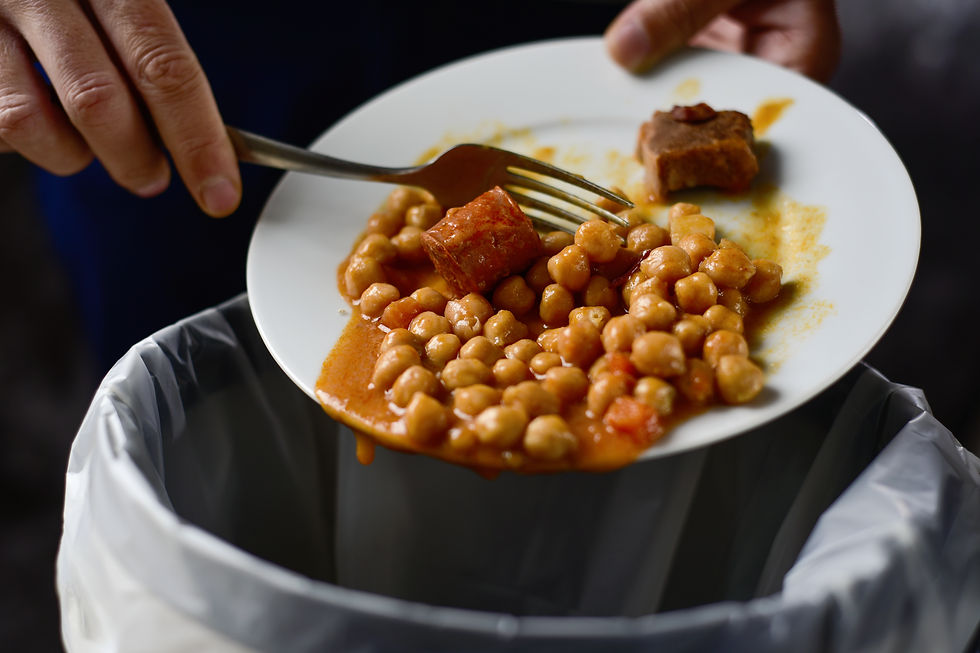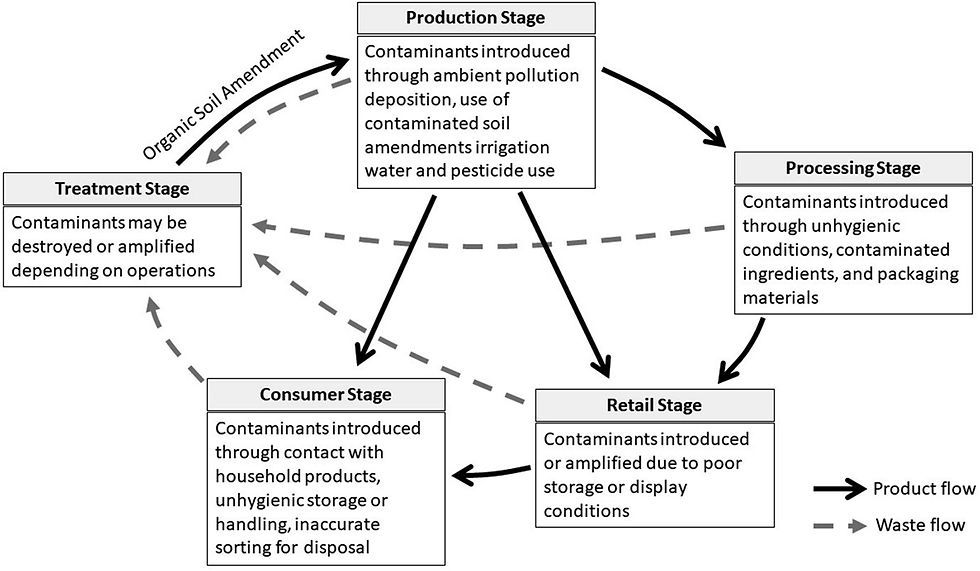A circular economy Part Two: Food waste
- Julia Jasonsmith
- Jul 4, 2022
- 7 min read
Updated: Apr 6, 2023
In my last blog, the pollution caused by unaccounted for chemicals in stormwater was discussed: from herbicides to PAHs, 6PPD-quinone through to neonicotinoids, stormwater in urban areas can comprise a toxic mixture of a great number of chemicals that, with few exceptions, present an unmitigated threat to aquatic environments.
Stormwater is not the only medium for which reuse and recovery is being pushed. In Australia and abroad, governments are driving the diversion of food waste from landfill to agricultural land. The Australian Government, for example, is investing 67 million dollars as part of this drive, helping the United Nations to meet their Sustainable Development Goal of reducing food loss and waste by 50%.
Like the recovery of stormwater, this push makes sense both scientifically and from a community perspective. There are many potential benefits from seeing food waste diverted from landfill to agricultural land, with food wastes containing many useful agricultural nutrients and causing methane emissions when landfilled. As with stormwater, however, the chemical impact of our industrial lives on the food waste stream is often unrecognised in environmental and food waste policies, regulations, and the scientific and ‘grey’ literature. Also, like stormwater, chemicals in food wastes can be hazardous and have the potential to present unacceptable risks to the environment if they are reintroduced to agricultural land in an inappropriate way. This blog explores the issue of contamination in food waste in greater detail.

Stock Photo ID: 572389627. Closeup of a young caucasian man throwing the leftover of a plate of chickpea stew to the trash bin
In the ideal circular model for food waste, the nutrients in food are returned to the agricultural soil from which they were drawn, thus reducing waste and the consumption of nutrients that otherwise need be purchased, creating a cycle of nutrient consumption and then return to agricultural soils. The problem is that this circular model for food waste does not acknowledge that contaminants—both chemical (e.g., phthalates and PFAS) and physical (e.g., plastic and glass)—are often introduced to foods at multiple stages of the process that sees food arrive in homes, be converted to food waste, and get transported back to farms. Thakali and MacRae (2021) present these sources of contamination to foods in the following image:

The physical wastes that can be introduced to the composts that are created as part of the process to return food wastes to agricultural soils summarised by O’Connor et al. 2022 include food packaging, food containers, plastic-coated paper such as is used in items like juice containers as well as paper bags, paper plates, utensils, tea bags, coffee cups, plastic-bag liners, plastic films, produce stickers, and non-compostable bags.
We are yet to understand the potential chemical impacts of some physical contamination. That is, beyond the not-nice-to-look at, the actual impacts of physical contaminants like plastics have been difficult to understand. This does not mean that impacts are not occurring, however, with decades usually required to understand the toxic impact of chemicals. The sheer extent of plastics pollution is also enormous, indicating that should negative impacts be identified, the chances of remediating the problem are poor. The German environment, for example, is currently estimated to receive between 35 billion and 2.2 trillion microplastic pieces larger than 1 mm every year due to compost application. This is despite Germany having some of the strictest regulations surrounding compost use in the world. Physical contamination is, however, known and acknowledged to be a problem in food wastes and the compost produced from it. Less known and acknowledged are the chemical contamination aspects, with these presenting a major threat to composting businesses and potentially the environment.
There are multiple examples available in Australia and abroad of chemicals in composts killing vegetable gardens and the plants used in landscaping. These chemicals are often introduced via manures and agricultural by-products. From the destruction of hundreds of vegetable gardens in Australia to big and mature trees in the US, the chemical contamination of composts by herbicides and pesticides, and the impact of these composts on the environment, is an increasingly acknowledged problem.
What is only rarely acknowledged or considered in current literature is the chemical contamination in food waste that is introduced at the processing and retail stage. This contamination occurs as a result of chemicals migrating from food contact materials into food products, before these food products are then composted. Now, for a long time, I believed the chemicals in food contact materials must be safe for human consumption and anyway couldn’t be occurring in high enough concentrations to be a problem. But I checked and found I was wrong.
In fact, there are many endocrine disrupting chemicals in food contact materials that migrate into packaged food. The estimated daily intake of phthalates in women in the US is 41.7 mg/kg/day, for example, a level that exceeds the tolerable daily intake level of 37 mg/kg/day. The concentrations of DEHP―a phthalate classified as toxic to reproduction—is up to 13 mg/L in bottled water, up to 242 mg/L in bottled wine, and up to 30 mg/L in raw milk. The phthalates in our food and bodies were all ultimately sourced and migrate from food packaging material.
The problem with chemical contaminants in food contact materials is the same as occurs in other forms of pollution: we often don’t know what the chemicals causing toxic impacts are, yet alone the conditions under which this toxicity occurs. A truly alarming study conducted by Zimmerman et al. (2021) for example, found that the chemicals migrating from all plastics assessed were toxic. Plastic coffee cup lids, plastic food wrap, yogurt containers, candy wrappers: all leached chemicals that were toxic under realistic conditions. Zimmerman et al. were unable to identify what most of the chemicals driving this toxicity were.
While there’s evidence that chemicals in food contact materials are toxic and migrating into foods, little has been done to investigate and prevent the introduction of these chemicals into food packaging in the first place. Research by Gueke et al. in 2014 found that 175 of the chemicals known to be used in European food packaging were of concern. This research was built upon in 2017 to outline how European rules could be used to ban the use of substances of very high concern—that is “primarily substances which are carcinogenic, mutagenic or toxic to reproduction as well as substances with persistent and bio-accumulative characteristics”―in food packaging. The list of chemicals used in food contact materials that was considered in this research included trichloroethylene, well known to those who work in the field of contaminated lands as being an industrial dry-cleaning chemical that has caused widespread contamination.
So far, I have been unable to find much more information regarding the potential environmental impacts of exposure to the chemicals in food waste introduced at the processing and retail stages. Based on research presented above, however, there is justified cause for concern.
There are many environmental benefits to a circular economy. However, a circular economy for food waste could potentially introduce and spread chemicals of concern from food waste packaging materials across vast tracts of land. That is because the negative impacts of the chemicals that are used in complex and poorly understood ways in our society are unfortunately exacerbated manifold by the failure to acknowledge the existence of such chemicals.
Though sparse, the research being undertaken out there highlighting these problems is excellent. I will finish up this blog with quotes that most eloquently describe the problems, drawn from this research:
‘These efforts underline the importance of broadening circular economy initiatives beyond their current focus on redirecting waste streams towards economically and ecologically beneficial uses... Facility managers wrestle not only with regulation that requires food waste recycling, but also with a regulatory system that fails to prevent upstream contamination of biological wastes.’
‘The United Nations Environment Program writes, “Improving the rate of resource productivity (doing more with less) faster than the economic growth rate is the notion behind decoupling” (2011:vx). This shift, the eco-modernist Breakthrough Institute argues, will require a “radical decoupling of humans from nature” (2015:23). Because it assumes that nature and society are separate, this eco-modernist thinking is myopic when it comes to recognizing the entanglement of biological and technical mate- rials in the creation of contemporary environmental problems, such as the contamination of food waste. Sometimes toxicants are entangled with food as far back as the farm, when pesticides were applied and remain, in trace amounts, on food products later discarded. In other cases, toxicants make their way in through food packages that contain, for example, PFAS designed to prevent sticking or the penetration of grease. As in many environmental discourses like that associated with the circular economy, an ecomodernist logic further deepens concepts of a nature-culture divide, by insisting that natural limits can be overcome by maintaining boundaries and through technological progress. As eco-mod- ernists Shellenberger and Nordhaus have notoriously written “The solution to the unintended consequences of modernity is, and always has been, more modernity” (2012:1).
This failure, or refusal, to recognize entanglement is not only built on a nature culture divide, but it also frames all problems and solutions as matters of applying human innovation to nature. It refuses to acknowledge that some problems have their roots in human political-economic sys- tems that enable environmental benefits and burdens to be distributed in highly unequal and unjust ways. In the context of circular food systems, this failure to recognize the politics of entanglement has created a system which holds compost- ers and digesters responsible for securing the line between biological and technical processes while the companies that produced trespassing chemicals accrue the benefits and, all too often, evade responsibility.’
‘Finally, our work suggests the need to think about the circular economy as more than a technical and economic fix. Instead, we need to think, with intention, about issues of justice and the distribution of environmental benefits and burdens as we transition toward more circular systems of production, consumption, and disposal. ‘
‘Diverting food waste to AD [anaerobic digestors] and composting for nutrient recovery will only be feasible and safe as long as the food waste is uncontaminated with other materials and toxicants, or the contaminants are destroyed by treatment. When contaminated food enters as feedstock for composting or anaerobic digestion and the residuals are used in agricultural soils, the contaminants can be taken up by the plants, resulting in human exposures.’



Comments